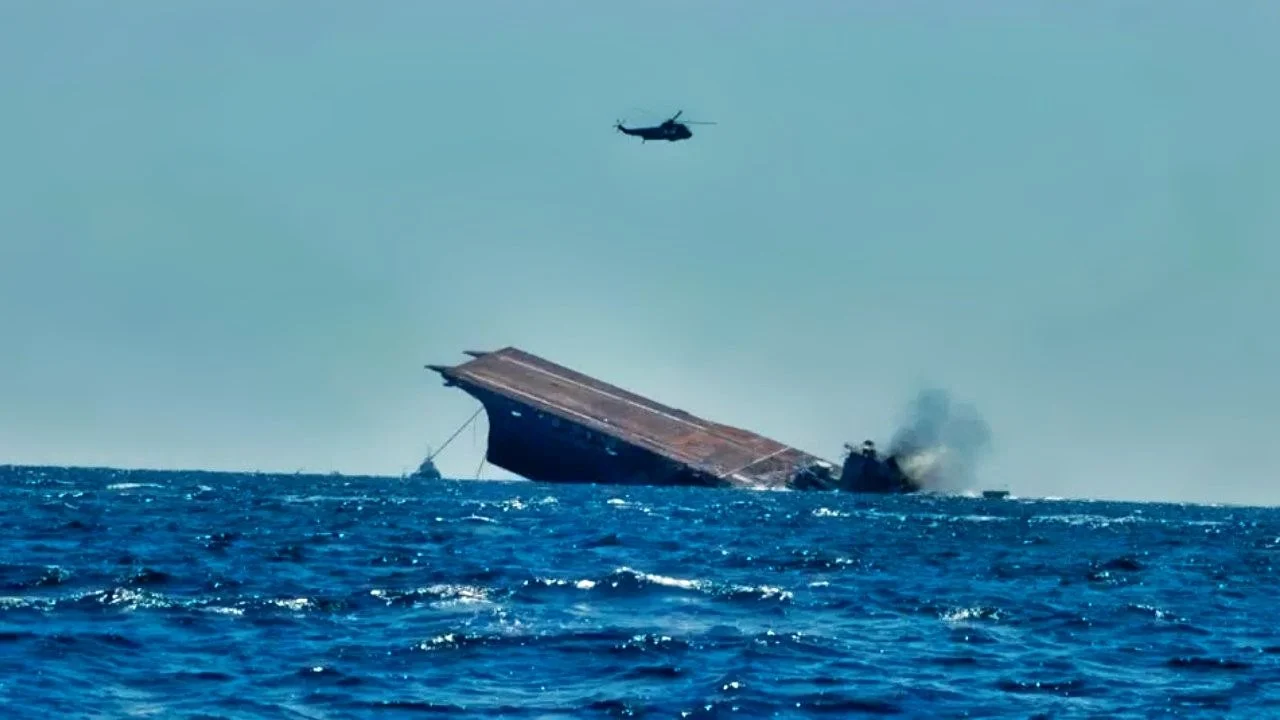At least, on paper, Iran could hit and maybe even sink a U.S. Navy aircraft carrier. However, in reality, going from on paper to real-world damage would be very hard indeed.
A detailed breakdown of Iran’s missile arsenal is available from the Center for Strategic and International Studies. “Iran possesses the large and most diverse missile arsenal in the Middle East, with thousands of ballistic and cruise missiles,” CSIS writes, adding that some of these missiles are capable of striking as far as Israel and southeast Europe.
Some of Iran’s anti-ship weaponry, including the Ra’ad anti-ship missile, has been deployed in the Strait of Hormuz.
“Iran has invested significantly to improve these weapons’ precision and lethality. Such developments have made Iran’s missile forces a potent tool for Iranian power projection and a credible threat to U.S. and partner military forces in the region,” CSIS explains. “Iran is also an active proliferator, supplying missiles and rockets to partner and proxy groups in Iraq, Lebanon, the Palestinian Territories, Syria, and Yemen.” The last country listed, Yemen, could be one of Iran’s more effective allies in the domain of anti-ship weaponry.
Iran has also developed a small boat-swarming fleet intended to rush larger surface ships and overwhelm a vessel’s defenses with a variety of anti-ship weapons. This fleet is meant to act in tighter coastal waters, where small ships would hope to negate larger surface vessels through superior speed and maneuverability.
Carrier Strike Group Defenses
Aircraft carriers do not operate alone, and the U.S. Navy’s flattops are no exception. The carriers are the core of a CSG, which includes destroyers, cruisers, submarines, and support aircraft that provide a layered defensive system against submarine threats, other surface vessels, aircraft, and anti-ship missiles.
In the case of American carrier groups, the U.S. Navy’s powerful Aegis Combat System is a very sophisticated apparatus that excels at defending from enemy aircraft and missiles.
Out to Sea
However, a CSG would likely stay farther out to sea, rather than operate in littoral waters nearer to Iran’s shores.
Staying at a distance helps avoid the risk posed by Iran’s anti-ship missile capability and the proliferation of small, speedy attack craft—essentially weaponized speedboats—that can launch some anti-ship weapons.
That being said, according to the most recent publicly available fleet tracking information made available by USNI News, the Harry S. Truman CSG is currently in the Red Sea, off the coast of Iran, while the Vinson CSG is currently underway to the Middle East from Asia for availability to U.S. Central Command.
Standing out farther to sea does have its advantages, even for offensive operations.
Aircraft such as the F/A-18 Super Hornets or the F-35 can conduct long-range operations while staying out of range of most Iranian land-based threats.
Thanks to a combat radius of 500 to 700 nautical miles, which expands significantly when aerial refueling aircraft are available on station, these aircraft can stay safe during sorties.
The Escalation Risk
An outright attack on a carrier strike group—particularly one that landed one or multiple hits—would almost certainly trigger a massive and rapid response against Iranian coastal installations, Iranian proxies like the Houthis, and perhaps a variety of targets within Iran itself.
In recent news, the U.S. Air Force appears to be massing a significant portion of its B-2 Spirit stealth bomber fleet, along with dozens of aerial refueling aircraft and cargo transports, at Diego Garcia, a British naval installation on an island deep in the Indian Ocean. Crucially, that island is well out of range of even Iran’s farthest-range ballistic missiles, and American air assets can operate from the island with impunity.
B-2 Spirits are among the few aircraft—and the only stealth aircraft—that are certified to carry and launch the GBU-57 Massive Ordnance Penetrator, the largest bunker-busting weapon in the world.
The GBU-57 would be an important part of any attack on Iran’s nuclear infrastructure, much of which is buried deep underground and protected by extensive concrete defensive structures.
Following the recent decimation of Iranian air defenses by Israel, including the elimination of all the country’s Russian-supplied S-300 air defense batteries, Iran is more vulnerable now than arguably at any point in the last several decades. Strikes against Iran’s missile production capability have reportedly been extensive, too.
Coupled with the battering of Iran’s proxies Hezbollah, Hamas, and the Assad family in Syria, Iran would have very little recourse to respond to widespread American retaliation following strikes on a U.S. Navy CSG.
Postscript
While Iran does possess a number of offensive weapons, especially anti-ship weaponry, a successful strike against an American aircraft carrier, let alone sinking one of the largest surface ships in the world, would be exceedingly difficult.
When factoring in the risk to Iran more broadly presented by retaliatory strikes, the incentive to execute a strike decreases, as the escalation dynamic would greatly favor the U.S. Navy.
About the Author: Caleb Larson
Caleb Larson is an American multiformat journalist based in Berlin, Germany. His work covers the intersection of conflict and society, focusing on American foreign policy and European security. He has reported from Germany, Russia, and the United States. Most recently, he covered the war in Ukraine, reporting extensively on the war’s shifting battle lines from Donbas and writing on the war’s civilian and humanitarian toll. Previously, he worked as a Defense Reporter for POLITICO Europe. You can follow his latest work on X.

